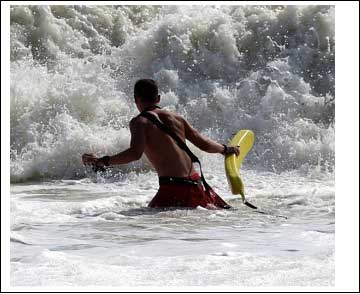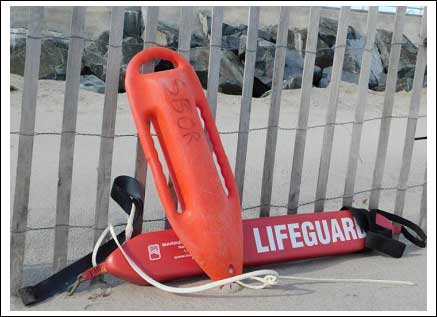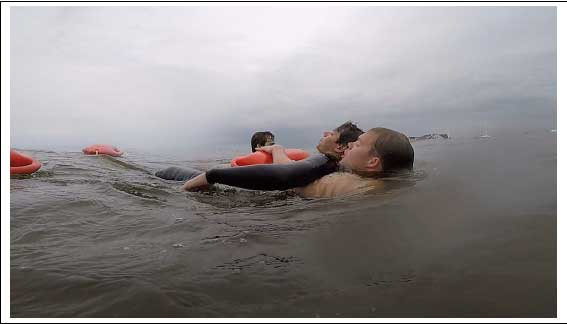Fins and Rescue Flotation Devices: A Winning Combination

By Mike Hudson
Give its extensive history, the fire service is fairly new to the open water rescue. As more people have the means to venture into the open water with wave runners, kayaks, two- day scuba classes, and stand-up paddle boards, firefighters are often thrust into the role of open water rescuer. A few municipalities—Ventura County, California; Bay County, Florida; Kauai County, Hawaii; Pierce County, Washington; New York City; and Sea Bright, New Jersey–have fire departments that have made successful water rescues for decades even before modern lifeguard services were available.
Over the last 20 years several municipalities have absorbed lifeguard operations. City of San Diego, Los Angeles County, and Miami Beach lifeguards perform their duties under command of the fire department using equipment that was designed and procedures that were developed long before falling under the umbrella of the fire service. Whether you are a firefighter rescue swimmer or lifeguard paramedic, rescue fins and a modern rescue flotation device (RFD) should be readily available for open water rescue.
The use of the RFD with rescue fins evolved on the beaches of California in the 1940s. Ocean lifeguards in Los Angeles County, some of them former Navy frogmen, understood that the extra power provided by using fins gave a valuable edge in big surf and rip currents. (1) Today, San Diego County and Los Angeles County (CA) fire department lifeguards are always required to have their department-issued rescue fins readily available while on duty. The combination of rescue fins while employing the procedures of a modern RFD has changed the application of surf rescue forever. This combination is also a great choice for long distance rescues in flat open water. It is important that the rescue tech understands the benefits, drawbacks, and perils of these simple but essential tools of the water rescue tradecraft.
The video below documents a training evolution gone bad. Rescuers without fins are no match for “permanent” rip currents found around structures in the surf zone. Almost every single member of the team was pushed through the supports of the pipe, unable to swim against the rip and side shore current. Video courtesy of Iain Henderson.
Rescue Fins are Personal Safety Equipment
The first practical use of swim fins as a tool to increase open water swimming ability and improve free diving came from the operations of Underwater Demolition Team (UDT) combat swimmers from World War II. These frogmen, some returning to their jobs as ocean lifeguards, understood the benefits of fins and how they could be applied to rescue procedures in the surf. Up until about 15 years ago the use of swim fins for water rescue along the Southeast and Mid-Atlantic regions was almost nonexistent. Rescue fins are considered standard equipment for open water rescue by the United States Lifesaving Association (USLA). (5). Rescue fins are usually made of rubber compounds and have nonadjustable heel straps allowing for easy donning and removal.
Some rescue fins have shortened wider blades to allow a rescuer to walk forward with ease, thus protecting their feet when entering the water from rocks, reefs, and jetties. Rescue fins should be ambidextrous and must fit the rescuer’s feet snugly with drain holes on the bottom.
Benefits:
- Rescuer safety: Studies show that swim fins significantly improve forward swimming and kicking performance. (2)
- Fins improve abilities used to mitigate aquatic hazards, especially large surf and rip currents.
- Rescuers reach their victims quicker using fins.
- Rescue fins are critical when retrieving a submerged victim from underwater.
- Rescue fins ease the fatigue associated with rescues in rip currents and big surf.
Drawbacks:
- Fins are not indicated for quick “grabs” or rescues in flat water near the shoreline when contacting the victim requires no more than a few arm strokes. (5)
- One size does not fit all.
Procedure Pearls: Rescue swimmers should be fiercely competent at donning rescue fins while in the water and removing them before exiting the water. Fins should be stored with the duty RFD or attached to a fin belt when operating a personal watercraft (PWC)/rescue watercraft (RWC). Adjustable SCUBA/snorkel fins should not be used as rescue fins particularly for surf rescue.(4)

RFD Overview
The RFD is used to raise a victim’s chest and head out of the water while putting them in a more hydrodynamic position to be towed through the water. An RFD is easily deployable on the run and can be used in a variety of ways to effect rescue. The torpedo buoy (Burnside buoy) and the rescue tube (Peterson tube) are the two most widely used RFDs and both have universal components to their designs.
Buoyancy: An RFD should float at least one adult victim head out of the water.
Lanyard: The line should float and be 7-9 feet in length, giving the rescuer the ability to push the RFD towards a panicking victim at a safe distance and giving time to employ defensive tactics if required. (3).
Harness: The shoulder harness is used to secure the RFD to the lifeguard. It should be sized correctly, quick to put on and easy to remove when the line has tension, as happens when the RFD is hung-up on structures or debris during operations around rock jetties or under bridges and piers. Rescue swimmers should practice removing the harness under tension.
RFD Color: The RFD is usually bright red or yellow so that the device can be easily seen by a rescuer and targeted by a victim.
Both the torpedo buoy and rescue tube are considered standard rescue equipment under NFPA 1006. (4) Photo: Jen Maloney Sea Bright, NJ
In the late 1930s, Santa Monica (CA) Lifeguard Pete Peterson invented the “rescue tube” so that lifeguards had more control over their victims in the surf. The Peterson RFD is made of foam and vinyl and has a brass clip system which allows a rescuer to secure the tube around a victim, making it the most versatile RFD for a rescue swimmer.
Benefits:
- The clip system gives the rescuer optimal control of an incapacitated victim.
- The rescuer can grasp the device and position the victim face up at arm’s length for more effective swimming and kicking with fins while keeping the victim’s airway out of the water.
- The rescue tube is the RFD of choice for PWC operations because of its ability to be secured easily aboard the craft or rescue sled.
Drawbacks:
- Provides only enough buoyancy to support one average-size adult victim
- The material of the Peterson tube degrades much quicker than that of the rescue buoy.
Procedure Pearls: During a PWC rescue of an unconscious victim, the rescue swimmer will deploy from the sled with the RFD. The rescuer will then contact the incapacitated victim, clip them into the RFD so that the tube is snug under the victim’s arms and then signal for pick-up. The rescue tube can then be used to help haul the victim onto the sled and control them during transit to shore.
Torpedo Buoy RFDs were originally made-up of a metal can and thick rope. In the 40s, legendary Los Angeles County (CA) Lifeguard Bob Burnside recognized that a 10-pound metal can tethered to a lifeguard in the surf was hazardous. Burnside replaced the metal buoy with one made of red plastic, creating the RFD fondly referred to as a “can” on the West Coast and a “torp” on the East Coast. (3) The Burnside RFD has handles that a victim can easily grasp. Partly because of the hit TV series Baywatch, the Burnside RFD has become the most recognized RFD in the world.
Benefits of the Burnside RFD:
- They are quick to deploy and primarily indicated when the victim is conscious since they can grasp its handles during the tow to shore.
- The rescuer does not need to make physical contact with the victim.
- This class of RFD comes in different sizes varying in buoyancy and can support multiple conscious victims.
- The Burnside RFD is durable and does not degrade easily.
Drawbacks:
- There is the potential for injury from a head strike especially in the surf or during insertion from a motorized watercraft.
- Not ideal for RWC PWC operations (see #1 above)
- It requires the rescuer to swim using a cross chest carry for unresponsive victims, which can be difficult with the average weight of an American adult now at 100kg.
Procedure Pearls: The rescuer enters the water ensuring the Burnside RFD is deployed behind them. The rescuer will don his or her fins and swim to the victim. Upon reaching the victim the rescuer, will hook the buoy under their arm and across their chest, signal for assistance, and start towards shore.

It’s a No-Brainer…
It has been proven over the years by professional open water lifesavers that using fins and an RFD can increase the potential for mission success. Rescue fins and RFDs are both quickly deployed on the run, they take up little space, and could be easily stored inside the tool compartments of modern-day fire apparatus. Thousands of professional ocean lifeguards and U.S. Coast Guard rescue swimmers can’t be wrong—fins and a modern RFD can give the firefighter rescue swimmer the edge they need to get themselves and their victim out of a dangerous situation.
REFERENCES
1. Aurthur C Verge. Images of America, The Los Angeles County Lifeguards. ISBN 0 7385 2898 -3. Arcadia Publishing, 2005
2. Mekjavic, I. B.; Rowe, P. A.; Morrison, J. B. (1 October 1982). “Ergonomic Considerations of Fin Size for Working Divers”. Proceedings of the Human Factors Society Annual Meeting. Sage Journals. 26 (6): 525–529. doi:10.1177/154193128202600608.
3. Maurice Schwartz, Encyclopedia of Coastal Science, University of WA ISBN 10 1420 3565 (e book). Stringer 2005
4. Steve Treinsih, Water Rescue Principals and Practices to NFPA 1006 20 3.2 and 20 3.3. Published by JBL 2018
5. B. Chris Brewster, Open Water Lifesaving, The Unites States Lifesaving Association Manual 3rd Edition. Pearson Publishing, 2017.
 Mike Hudson is a former U.S. Navy Corpsman and current nationally registered paramedic with over 25 years on the streets. In the winter, Mike works for the Discovery Channel and also works as a street level MICP in central New Jersey. In the summer, he commands a municipal USLA-certified lifesaving agency that provides river lifeguard and ocean lifeguard services for two coastal towns and serves as the lead ocean rescue specialist for a combined fire-department/lifeguard aquatic rescue response team, surf rescue team 43-88 (SRT 43-88), headquartered along the north shore of Monmouth County, New Jersey. For more information about SRT 43-88 go to seabrightoceanrescue.com.
Mike Hudson is a former U.S. Navy Corpsman and current nationally registered paramedic with over 25 years on the streets. In the winter, Mike works for the Discovery Channel and also works as a street level MICP in central New Jersey. In the summer, he commands a municipal USLA-certified lifesaving agency that provides river lifeguard and ocean lifeguard services for two coastal towns and serves as the lead ocean rescue specialist for a combined fire-department/lifeguard aquatic rescue response team, surf rescue team 43-88 (SRT 43-88), headquartered along the north shore of Monmouth County, New Jersey. For more information about SRT 43-88 go to seabrightoceanrescue.com.
ALSO
Fire Department EMS: Thinking Outside the Box for COVID-19
Drifting Towards Catastrophe: What Water Rescue Teams Can Learn from Air Medevac Procedures

